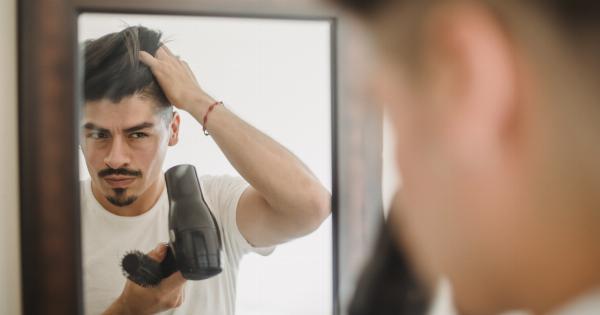Hair loss is a common concern for both men and women, and it can have a significant impact on self-esteem and confidence. Many people wonder what causes hair loss and whether there are effective treatments available.
In this article, we will explore the truth about hair loss, including its causes, possible treatments, and lifestyle factors that can contribute to hair health.
What Causes Hair Loss?
There are various factors that can contribute to hair loss, including:.
1. Genetics
One of the most common causes of hair loss is genetics. Male and female pattern baldness, also known as androgenetic alopecia, is primarily caused by inherited genes.
This type of hair loss typically starts with a receding hairline or thinning at the crown and can progress over time.
2. Hormonal Changes
Hormonal changes can also cause hair loss. Pregnancy, childbirth, menopause, and thyroid problems can all disrupt the natural hair growth cycle, leading to excessive shedding or hair thinning.
Hormonal imbalances can affect the production of new hair follicles, resulting in hair loss.
3. Medical Conditions
Certain medical conditions, such as alopecia areata, scalp infections, and trichotillomania (hair-pulling disorder), can cause hair loss. Additionally, chronic illnesses like diabetes and lupus can also impact hair health.
It is essential to address the underlying medical condition to prevent further hair loss.
4. Stress and Trauma
Physical or emotional stress can contribute to hair loss. When the body experiences significant stress, it can divert nutrients away from hair follicles, resulting in weakened hair growth.
Traumatic events, such as surgery or a severe illness, can also cause temporary hair loss.
5. Poor Nutrition
A balanced diet rich in vitamins, minerals, and proteins is crucial for healthy hair growth. Nutritional deficiencies, such as inadequate iron, zinc, or vitamin D, can lead to hair loss.
Crash diets and unhealthy eating habits can deprive the body of essential nutrients, negatively affecting hair health.
6. Certain Medications
Some medications have hair loss as a side effect. Chemotherapy drugs, anticoagulants, blood pressure medications, and antidepressants are among the medications that can cause hair loss.
If you are experiencing hair loss while taking any medication, consult your healthcare provider for possible alternatives.
7. Hairstyling and Hair Products
Excessive hairstyling, such as frequent use of hot styling tools, tight hairstyles (like braids or ponytails), and harsh chemical treatments can damage hair follicles and lead to hair loss.
Certain hair products containing sulfates, parabens, or alcohol can also cause scalp irritation and hair damage.
Possible Treatments for Hair Loss
While there is no guaranteed cure for hair loss, certain treatments can help slow down hair loss or promote regrowth. These include:.
1. Medications
Two medications approved by the FDA for the treatment of hair loss are minoxidil and finasteride. Minoxidil is a topical solution applied directly to the scalp, while finasteride is an oral medication available for men only.
These medications can be effective in slowing down hair loss and promoting regrowth in some individuals.
2. Hair Transplantation
Hair transplantation involves removing hair follicles from one area of the body (often the back or sides of the scalp) and transplanting them onto the balding areas.
This surgical procedure is suitable for individuals with significant hair loss and can provide natural-looking results.
3. Low-Level Laser Therapy
Low-level laser therapy (LLLT) uses light energy to stimulate hair follicles and promote hair growth. This non-invasive treatment can be done at home using handheld devices or in specialized clinics.
LLLT has shown positive results in stimulating hair growth in some individuals.
4. Scalp Micropigmentation
Scalp micropigmentation is a cosmetic tattooing procedure that involves injecting pigment into the scalp to mimic the appearance of hair follicles.
This technique can create the illusion of a full head of hair, making it an attractive option for those with extensive hair loss.
Lifestyle Factors for Healthy Hair
While there may not be a foolproof way to prevent hair loss, adopting certain healthy habits can promote hair growth and improve overall hair health. Consider the following lifestyle factors:.
1. Balanced Diet
Eat a nutritious diet that includes plenty of fruits, vegetables, lean proteins, and healthy fats. Foods rich in vitamins A, C, E, biotin, and iron can support hair growth. Drinking an adequate amount of water is also essential for scalp and hair health.
2. Gentle Hair Care
Avoid aggressive brushing, excessive heat styling, and tight hairstyles that can cause hair breakage and damage. Use a wide-toothed comb or a brush with soft bristles to detangle hair gently.
Allow hair to air dry whenever possible and limit the use of heat styling tools.
3. Stress Management
Practice stress reduction techniques such as meditation, yoga, or deep breathing exercises. Engaging in activities you enjoy and prioritizing self-care can help reduce stress levels, which can contribute to healthier hair.
4. Regular Exercise
Regular physical activity improves blood circulation, including to the scalp. This increased blood flow can help deliver essential nutrients to the hair follicles, promoting hair growth. Aim for at least 30 minutes of exercise most days of the week.
5. Avoid Smoking and Excessive Alcohol Consumption
Smoking restricts blood flow, including to the scalp, which can negatively impact hair health. Excessive alcohol consumption can also dehydrate the body and lead to nutrient deficiencies. Limit smoking and alcohol intake for optimal hair health.
Conclusion
Understanding the truth about hair loss is essential for those experiencing this common condition. While genetics and hormonal changes play a significant role, lifestyle factors and certain treatments can help slow down hair loss and promote regrowth.
By adopting a healthy lifestyle and seeking appropriate treatments, individuals can maintain healthier hair and boost their self-confidence.























